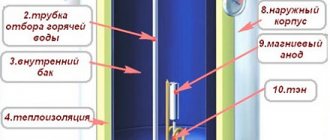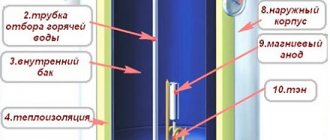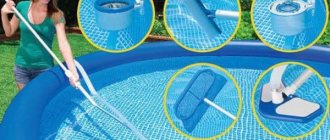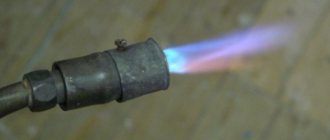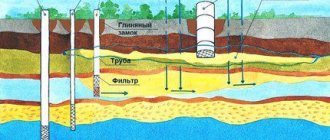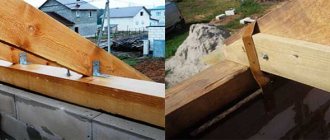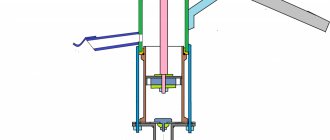Today, even in comfortable apartments with a centralized supply of hot and cold water, a water heating boiler, or as it is also called “Ariston,” is a common piece of furniture. This is how modern people, accustomed to comfort, insure themselves in the event of a preventative shutdown of hot water or in the event of a hot water supply failure. The distribution network offers storage water heaters of various sizes, brands, and countries of origin; you just need to go to any plumbing store to be convinced of this. But the feeling of satisfaction from using a water heater can easily disappear if it is not connected or maintained correctly. Then simply draining water from the boiler turns into a serious technical problem.
Do I need to drain the water from the water heater?
There are so many electrical appliances in every home that it is difficult for a person to remember how to operate each of them, and some require regular maintenance. For example, a boiler installation may require draining or do without this procedure, depending on the model of the device, the material from which it is made and additional conditions. If you turn to specialists, they will confidently confirm that it is necessary to carry out this procedure periodically and will even explain how to drain the boiler. Turning to experts requires costs and to save money, you should understand this process yourself. Remember that these actions become mandatory in the following cases:
- In places where there is a sharp change in climate. It is better to drain twice a year: before the onset of frost and after it. This action minimizes the risk that the tank will lose its seal if the water in it turns to ice.
- If an emergency occurs at a waterworks. After completing the repair work, it is worth carrying out the procedure.
- In the event of a prolonged absence of water supply or if the water is heavily contaminated.
If an accident occurs or a long outage is imminent, you need to understand that water will not flow into the boiler until the water supply is restored. It is advisable to remove the residues from the boiler system or completely use the remaining resource. Sometimes the device itself can be misleading. The following picture shows two taps, but they are both blue. In this case, difficulties arise.
Boiler with two blue taps Source santehnikportal.ru
Removing sediment
There is nothing complicated about removing liquids with heavy impurities from the bottom of the boiler tank. But it is recommended to trust this procedure to specialists. Maintenance of the device is carried out at the place of its installation or on the floor after preliminary dismantling.
Procedure:
- The casing is removed from the device.
- All electrical wires are disconnected.
- Using a gas wrench, unscrew the union nut holding the heating element.
Once the tubular heater is loosened and loosened, dirty liquid will immediately begin to flow from under it. Therefore, you should have a bucket or other container on hand to drain the sediment.
The electric heating element is completely removed and the remaining liquid and dirt in the heater tank is removed through the resulting hole. For additional flushing, you can slightly open the valve that cuts off the cold water supply.
After the container is completely cleaned, the equipment is reassembled in the reverse order. In this case, the main task is the hermetically sealed installation of heating elements in their place.
Features of heating devices
Each device has its own features of use and assembly nuances. Before carrying out any measures to repair equipment or take preventive actions, it is worth reading the instructions that came with the equipment. This manual will give a complete understanding of what valve or lever means. Before figuring out how to drain the water from the boiler, it’s a good idea to familiarize yourself with the nuances of the issue:
- First, inspect the room where this device is located. If the boiler room or utility room is constantly heated, then this process is not necessary, even if the homeowners are going to leave for a long time.
- If the boiler structure is made of stainless steel, then corrosion of the metal in a humid environment will occur much faster, and periodic draining is not necessary.
Stainless steel boiler Source stroy-podskazka.ru
- The copper container sometimes needs to be completely emptied of water. Copper is very sensitive to hard water and if a person leaves for a long time, it is better to leave the tank empty.
- If the water supply comes from a central water supply and not from a well, then draining is not necessary, because the bleach contained in the water will not allow bacteria to multiply and prevent the appearance of an unpleasant odor. Wells do not have this property.
- If owners of a water heating system use a well, then periodic draining is necessary. This will prevent water stagnation and rotting.
If stagnation does occur, then the boiler device needs to be flushed. To do this, you need to turn on the tap and drain water from the tank for a long time until the cleaning occurs. After this, the new water in the container must be heated several times.
After complete drainage, new water needs to be heated several times Source sovet-ingenera.com
See also: Contacts of construction companies that specialize in working with engineering systems of a private home
Relief via safety check valve
This method is recommended to be used by all well-known manufacturers of water heating tanks - Ariston, Thermex, Gorenje, Electrolux and so on. The household appliance is connected to the water supply networks according to the diagram (shown above) from the operating instructions:
- a safety group for boilers is installed at the inlet pipe;
- A shut-off valve is placed in front of the group;
- no fittings are provided at the outlet pipe or a ball valve is installed.
Explanation. The safety group is an automatic 3 in 1 element, it includes a check valve + safety valve + drain valve with a plastic lever.
Sometimes there are valves without a lever - you can’t drain water through such a valve.
How to drain water through a valve:
- We shut off the water main at the entrance to the apartment and disconnect the heater from the power supply.
- We release 1-2 liters through the nearest mixer, opening the DHW valve all the way. We leave the plumbing fixture in the open position so that air can fill the void in the tank.
- We place a bucket under the “spout” of the valve, turn the lever and slowly empty the tank.
Before emptying, the heating device does not need to be disassembled and wait for the water to cool. Disadvantages of the method:
- due to the small flow area of the spout (5...8 mm), the water drains too slowly, a boiler of 80-100 liters will be emptied in about 2 hours;
- the valve often becomes clogged and does not allow liquid to pass through well;
- sometimes the security group turns sour, the drain does not work at all.
The method is suitable for small water heaters of 25-50 liters, provided that the valve valve functions normally. It will take too long to release large volumes.
On the left in the photo is a clogged poppet valve, on the right is a measurement of the drain passage (5 mm)
Methods for draining water from a boiler
There are several options that will tell you how to drain the water from the water heater. The easiest way is to drain the liquid through the cold opening of the incoming hose. In this case, it is necessary to open air access through the “hot” hose. This is easy to do, but boiler designs do not always allow the procedure to be carried out without damaging the container. In this regard, let's consider other options.
On a note! When tightening nuts, use a gas wrench or wrench.
A gas wrench is very suitable for unscrewing nuts Source vteple.xyz
Safety tap
The first way to drain water from a boiler is to carry out the procedure through the safety valve of the device. Every heater has this valve if the installation was carried out according to all the rules. The trigger mechanism is located at the entrance to the tank, where the cold pipe or hose is located. It is designed for emergency drainage when the pressure is too high. The connecting screw is easy to unscrew. This is how many people check the functionality of the device. If water does not flow out when opened, it means that a blockage or breakdown has occurred and requires cleaning or replacement.
By opening the valve of the emergency device, drainage occurs easily. It is worth worrying in advance about the container where you will need to collect the liquid. The water speed will be low. If the water heating tank is large, for example, 80 liters, then emptying it will take at least two hours. If there is a blockage, the process will take twice as long. A person can drain the water and at the same time make sure that there is no blockage.
On a note! If the blockage is severe, it will be impossible to remove the liquid in this way.
When draining water, you can also clean the pipes Source santehnikportal.ru
Using a trim with a drain valve
The method significantly simplifies the procedure for emptying the water heater. One condition: the piping diagram must have a drain valve installed on the tee after the relief valve, as shown in the picture below. Next is a matter of technology:
- We cut off the cold water pipeline with a valve, turn off the power supply, and open the hot water on the mixer.
- We attach a hose of the required length to the drain tap fitting and prepare a bucket.
- Open the valve and drain the contents in portions.
There is no need to disconnect the pipes; if necessary, the flow can be easily stopped with a tap. The hose does not spray because the mixer restricts the flow of air into the tank. A 50 liter water heater is emptied in 10-15 minutes.
The piping diagram does not show drainage from the relief valve to the sewer system
Important point. Manufacturers of water heating equipment do not welcome this piping option. Reason: there is a tee with pipeline fittings between the safety group and the boiler, which is not allowed by the rules.
Practice shows: installing an additional valve does not pose a threat if the user does not drain sanitary water when the heater is on. In this case, the level in the tank decreases, the water heating element can “surface”, overheat in the air and quickly burn out.
The second condition: the tee must not become clogged, otherwise the path to the relief valve will be closed. Then, when heated, the expanding liquid will rupture the hot water pipeline or the container itself.
Complete emptying of the boiler tank
Remember that any of the above drainage options is not perfect, and not everyone allows you to completely drain the water from the boiler installation. To completely empty the tank, you will need to disassemble the water heater:
- After the liquid has partially drained, you need to unscrew the cap, which is located at the bottom of the tank. On most boiler systems it serves only as a decoration.
- Make sure that the device is not connected to electricity. If draining can be done with a connection to the network, then disassembling the device is strictly forbidden.
- The cover cannot be removed completely, so the following steps must be carried out while holding it. Very carefully disconnect the wires from the warning light.
- Then it is necessary to disconnect the electrical wiring from the installation body. Experts recommend photographing the location of the wires so as not to get confused later during reassembly.
- Then you need to unscrew the flange. This mechanism must be rotated counterclockwise. Residual water will begin to flow, so unscrewing must be done slowly so as not to strip the thread. By the pressure it will be possible to understand that there is little liquid left and then complete the final unscrewing.
Draining water from a boiler may seem difficult at first glance Source www.timberk.ru
Useful tips
In order not to damage water heating equipment when cleaning it yourself or replacing faulty parts, you must adhere to the following recommendations from specialists:
- any work related to the maintenance of electrical equipment is carried out only when it is completely de-energized;
- You must first study the instructions from the manufacturer, which indicate the design and procedure for assembling/disassembling the device;
- If unpleasant odors begin to appear when using the boiler, once every 2 months you need to run 100 liters of clean cold water through it.
Draining liquid from an Ariston water heater is easy to do if it was installed according to the manufacturer's instructions. It is not recommended to change the device connection diagram yourself. This may not affect the operation of the equipment itself, but it will definitely complicate future maintenance.
Why is the procedure needed?
The event is simple, takes a minimum of time, knowing all the nuances, it can be carried out without the help of specialists. It is necessary in three situations:
- Location of the water heating device in a cottage or other unheated room. Since it will not work all season, the liquid should be removed for the winter. This is due to the fact that under negative temperature conditions, ice will begin to form and the likelihood of boiler failure will increase.
- Replacing the magnesium anode. All work is allowed to be carried out exclusively in a dry container. Replacement is required at least once every 12 months. Magnesium strongly attracts various impurities, which prevents them from settling on the walls and causing spontaneous destruction of metals. They only corrode the base without affecting the material of the equipment.
- Cleaning the container (tank). The main reason is the accumulation of scale. Against the background of water hardness, when heated, heavy impurities settle on the surface (a plaque is formed). After a few days, it begins to harden, which interferes with the heat transfer of the tubular electric heater. As a result, electricity consumption increases significantly (by about 30-40%), but sufficient heating does not occur. In addition, the proliferation of pathogenic microorganisms is also the cause of drainage.
A number of signs will indicate the need for an event. These include: the appearance of strong noise during operation, leakage, long heating times of the liquid and low pressure.
Important! If the boiler is still under warranty, you should call a service center technician for cleaning.

